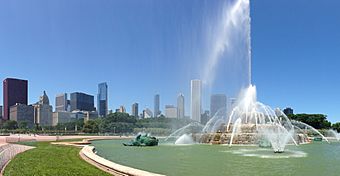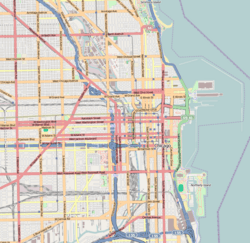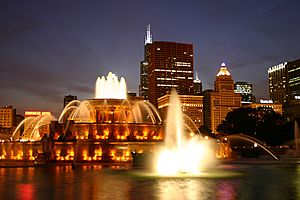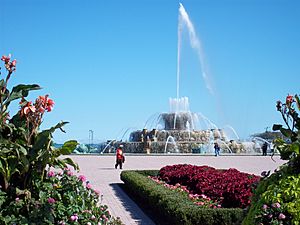Buckingham Fountain facts for kids
Quick facts for kids |
|
|
Buckingham Fountain
|
|
|
U.S. Historic district
Contributing property |
|

Buckingham Fountain in Grant Park
|
|
| Location | Chicago |
|---|---|
| Area | Downtown Chicago |
| Architect | Bennett, Edward H.;
Lambert, Jacques H.; Loyau, Marcel Francois |
| Architectural style | Beaux Arts, Art Decomo |
| Part of | Grant Park (ID92001075) |
| Added to NRHP | July 21, 1993 |
Buckingham Fountain is a famous landmark in the middle of Grant Park in Chicago. It sits between Queen's Landing and Ida B. Wells Drive. This huge fountain was opened in 1927. A kind person named Kate S. Buckingham gave it to the city. It is one of the biggest fountains in the world!
The fountain looks like a fancy wedding cake, inspired by the Latona Fountain at the Palace of Versailles in France. Its design shows the nearby Lake Michigan. The fountain usually runs from May to mid-October. You can see cool water shows and even light shows at night. In winter, the fountain is decorated with bright festival lights.
Contents
History of Buckingham Fountain
The area around the fountain is like Chicago's main entrance. It is in the center of Grant Park, which is often called the city's "front yard." The fountain itself stands for Lake Michigan. It has four sets of sea horses. These sea horses represent the four states that touch the lake: Illinois, Wisconsin, Michigan, and Indiana.
A talented architect named Edward H. Bennett designed the fountain. The statues were made by a French sculptor named Marcel F. Loyau. The design was inspired by a fountain at the famous Palace of Versailles in France.
The fountain was a gift to the city from Kate Sturges Buckingham. She gave it in memory of her brother, Clarence Buckingham. It cost $750,000 to build. Its official name is the Clarence Buckingham Memorial Fountain. Kate Buckingham also set up a special fund with $300,000. This money helps pay for the fountain's care and upkeep. Buckingham Fountain was officially opened on August 26, 1927.
In 2016, the area around the fountain got free Wi-Fi. This was a team effort between the City of Chicago, the Chicago Parks District, and Everywhere Wireless. Now, visitors can easily connect to the internet.
How the Fountain Works
Many people, both tourists and Chicago residents, visit the fountain every year. The fountain usually runs daily from 8:00 a.m. to 11:00 p.m. This is from mid-April through mid-October. If it gets too cold and freezes, it might close earlier.
Water shows happen every hour, right on the hour, and they last for 20 minutes. During these shows, the water from the center jet shoots up very high, about 150 feet (46 meters) into the air! After the sun sets, the shows become even more special. They are set to lights and music. The last show of the night starts at 10:00 p.m.
The fountain is made from pink marble from Georgia. It holds about 1.5 million gallons (5.7 million liters) of water. During a show, more than 14,000 gallons (53,000 liters) of water flow through its 193 jets every minute. The bottom pool of the fountain is 280 feet (85 meters) across. The lower basin is 103 feet (31 meters), the middle basin is 60 feet (18 meters), and the top basin is 24 feet (7.3 meters). The top basin's edge is 25 feet (7.6 meters) above the water in the lower basin.
A special computer controls the fountain's pumps. This computer used to be in Atlanta, Georgia. But in 1994, it was moved to the fountain's pump house. The fountain's security system is watched from Arlington Heights, a suburb of Chicago.
Fountain Updates and Repairs
In 1994, the fountain had a big repair project that cost $2.8 million. Its three smallest basins had leaks because of Chicago's cold winters.
Another big repair project started in September 2008. This project has three parts. It aims to update the fountain's old internal systems and fix parts that have worn out. Money for these repairs comes from the Buckingham fund, city and park district money, and a grant from the Lollapalooza music festival. This festival happens every year near the fountain.
Phase I was finished on April 3, 2009. This part included putting in new, special pavers around the fountain. These pavers replaced the crushed stone that had been there since the fountain was built. The new pavers make the area safer and smoother. They also follow rules to make it easier for people with disabilities to visit.
Phase II began in the winter of 2009. This phase involved taking apart the fountain table and adding a new drainage system. It also included new landscaping, lights, signs, and seating. Some parts of the outer basin were fixed or replaced. This work was not fully finished because there wasn't enough money. The Chicago Park District has not yet said when this phase will be completed.
Phase III updates have not been planned yet. They will start after Phase II is done. This phase will fix the main Buckingham Fountain and its table. It will also build a new room for equipment, do structural repairs, fix masonry, and restore bronze parts. New improvements and features will also be added to the site.
Buckingham Fountain in Pop Culture
On TV and in Movies
Buckingham Fountain has been seen in many TV shows and movies!
- It was in the opening scenes of TV shows like Married... with Children and Crime Story.
- The fountain was the starting point for the TV show The Amazing Race 6 in 2004. It was also featured in a challenge on The Amazing Race 29 13 years later.
- You can spot the fountain for a few seconds in the 1983 movie National Lampoon's Vacation.
- It appears in the 2003 comedy Crime Spree when criminals arrive in Chicago.
- The fountain is also shown in the TV show Shameless.
- It was featured twice on the TV show The Great Food Truck Race.
- The fountain appears in the 1949 film Undertow.
- It is also in the 2021 movie Thunder Force.
Not the End of Route 66
Many people mistakenly think Buckingham Fountain is the end point of the famous historic road, U.S. Route 66. This road goes all the way to California! However, even though the fountain is close, it was never the actual end point.
The real eastern end of Route 66 was nearby, at the corner of Jackson Boulevard and Michigan Avenue in downtown Chicago. Later, the end point moved a bit further east into Grant Park. It moved to the corner of Jackson and Lake Shore Drive.
Even though the fountain wasn't built when Route 66 opened in 1926, many still connect it with the start of the route. Today, because Jackson is a one-way street going east, the signs for Route 66 show "End" at Jackson. But the "Begin" signs are now one block north, on Adams Street, which goes west.
See also
 In Spanish: Fuente de Buckingham para niños
In Spanish: Fuente de Buckingham para niños








